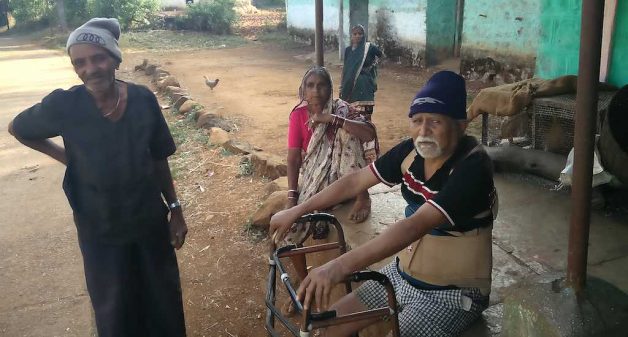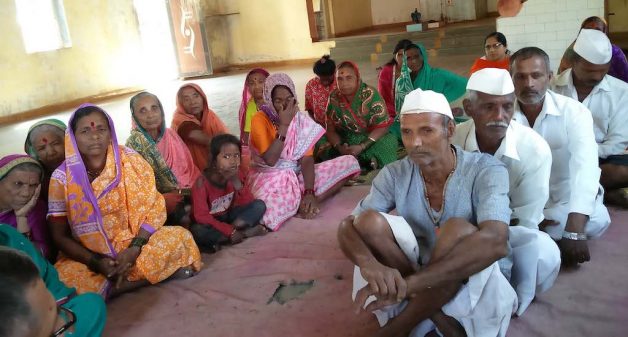
Healthcare of elderly suffers with youth migration
With little livelihood opportunities in villages, the youth in rural Maharashtra migrate to cities, leading to delayed healthcare of elderly dependents and increased medical expenses

With little livelihood opportunities in villages, the youth in rural Maharashtra migrate to cities, leading to delayed healthcare of elderly dependents and increased medical expenses
Almost all the youngsters of Ghisar village are in Pune city for work, hunting for jobs or struggling to make a living. The same holds true of almost all the villages in Velhe taluk of Pune district. One can see young faces only during festivals. Surrounded by hills and unfertile rocky land, agricultural income is often not sufficient. Unfortunately, there is no other major livelihood opportunity in the vicinity.
With no young people around, the elderly had to change their lifestyle. They have to wait for proper medical care for weeks until the youth return and take them to a hospital. The primary health center (PHC) in Pasli caters to Ghisar village. But travelling to Pasli is not practical as it is 35 km away; commuting to the rural health center (RHC) at Velhe (21 km) is a better option.
However, higher referral centers ask for a referral letter from Pasli PHC for getting concession. In the absence of youth to assist them, it is difficult for the elderly even to seek proper healthcare during emergencies.
Changing demography
Unlike high-income countries, Indian rural elderly rely on the youth in the family. However, the situation is changing fast. Villages, once prosperous with people and culture, have a skewed population today. Villages today have a higher older (more than 60 years) population than ever.
According to Census 2011, 70.56% of the elderly are in rural areas as against 29.44% in urban areas. This is seen more in rapidly urbanizing states. Maharashtra is the third after Tamil Nadu and Kerala in the list of rapidly urbanizing states, if the statistics are compared with that of Census 2001.
However, in absolute numbers, Maharashtra ranks first, with more than 50 million people residing in urban areas. These urban centers have an increasing need for human resources, especially in the informal and semi-formal service sectors that attract rural youth.
The youth in villages are frustrated, as they see no scope for their aspirations or development in their villages. Disheartened by lack of money and daily hardship, they move to cities in droves. There is also reverse migration of the elderly from cities to villages after retirement.
Unutilized beneficial schemes
As there are no youngsters in the villages who can question and take up matters with officers, there is less pressure on government systems. Also, illiterate and less confident, the elderly cannot run around to get the benefits of various schemes.
Often in many villages, PHCs lack staff, or there is a dearth of medicines. Youngsters often cannot spare time to attend to the health needs of the elderly during their brief visits. “Our kids come here like guests. What all can we ask them to do? We have to plead them for everything,” said an elderly lady.

When intervention cannot be avoided, they take the elderly to cities or private clinics, adding to the overall expenditure. This heavy expenditure adds to the emotional burden of the elderly. “My lower back operation cost Rs 6 lakh,” said a senior citizen. They are not aware of the national health insurance scheme for the poor. Enrolling in the scheme can prevent catastrophic health expenditure of many families.
Associated health risks
In 2011, the disability rate among the elderly was 51.8 per 1,000 and 84.1 per 1,000 for the octogenarian population, which is very high compared to high-income countries. Also, 76.19% of the disabled elderly are in rural areas. These disability rates do not count impairments like an inability to walk due to knee pain or vision impairment due to cataract, etc.
If such impairments and dysfunctionalities are considered, the number will be very high. As per the Building Knowledge Base on Population Ageing in India (BKPAI) research project 2011, 64.8% of the elderly suffer from some chronic disease or the other. Also, many elements like diabetes and hypertension need monitoring, regular checkup and medication.
The non-availability of medicines is also a significant issue. All of this translates into excessive suffering, impairment, disability and low quality of life. Such life affects the psyche of the elderly, leading to excessive depression.
As per one study in rural northern India, 11.4% elderly had depression, and it was more among people with chronic diseases, disabilities and impairments. The BKPAI report also says that around three-fourths of the elderly are dependent financially on others and half of the elderly face some form of abuse.
Implementation of schemes
The National Program of Health Care for the Elderly (NPHCE), started in 2011 in 100 selected districts, is meant exclusively for the elderly population. The program was expected to expand over some period. Under this program, infrastructure and healthcare delivery centres are to be built from tertiary to primary health centre level with specialists and trained medical cadre.
Dedicated elderly clinics and camps are expected to happen at a certain frequency in the public health facilities at the grassroots with dedicated ward facility at district hospitals. However, there is inactivity and low fund utilization. Most of the states have single digit percentages of fund utilization rate for this program.
The program is now managed by Non-Communicable Diseases Cell, increasing further confusion. It is not clear how a senior citizen, whose children are away from her, can avail the program’s benefits. While the program document mentions outreach, there is no clarity about the related activities.
This vertical program is far from successful as the intended beneficiaries are completely unaware of it. Rashtriya Vayoshri Yojana, which gives free aids and assistive living devices to needy elderly, is another such scheme that is yet to reach rural areas effectively.
“Special clinic for elderly? Oh, sir, first ask them to run the PHC; all such things are just empty talk,” said a senior citizen. Today, the average rural elderly are not aware of the program or the elderly healthcare centers around them.
Challenges of youth migrants
Young men struggle in cities without any peace of mind as their parents, and in many cases, their wives are in villages. “His life is not easy. He has to work very hard alone in the city and manage the expenses on multiple fronts,” said an elderly mother about her son.
The struggling young men cannot afford to take their newly married wives to cities, at least in the early phase of their career. This affects their relationship in an unusual manner. Also, those women are burdened by the additional task of taking care of their elderly parents-in-law. “He left me here to work like a donkey; I have to manage everything here,” said a woman.
Future trend and needs
Migration of youth to cities for better education, employment and life is an unstoppable phenomenon. Also, as our demographic dividend closes, the proportion of the elderly would keep increasing. By 2050, proportion of the elderly in total population would be 19%, which is 8.7% at present.
It is also the year when our annual growth rate will be surpassed by the annual growth rate of the elderly. In the coming three decades we will be grappling with the problem of a huge number of dependents needing medical care.
Rural areas are likely to see the worst situation, as urbanization will suck all the youth from villages. If we need to see active and healthy ageing of the future elderly, we need to start aggressive interventions in rural areas with a focus of outreach.
There are multiple angles to be considered to build an effective intervention to improve health access of rural elderly, but proper implementation of existing programs could be a good start.
Abhijeet Jadhav works with VikasAnvesh Foundation in Pune. Earlier he was faculty at Tata Institute of Social Sciences, Mumbai. Views are personal.